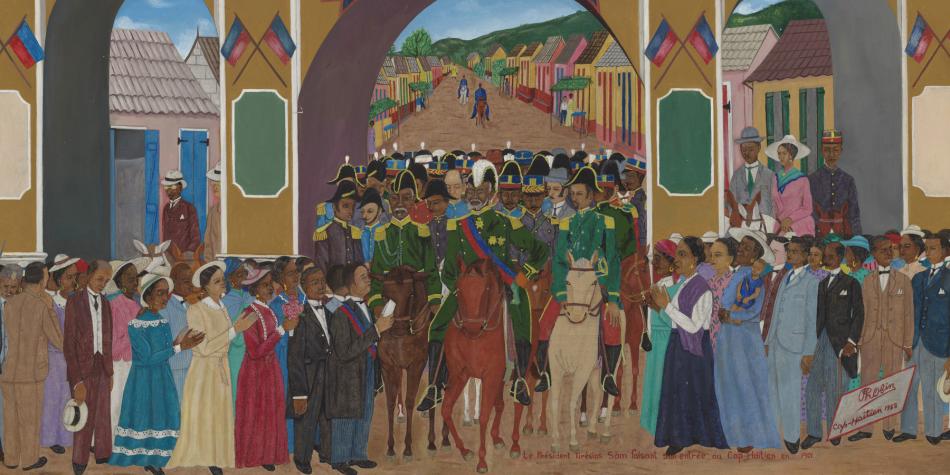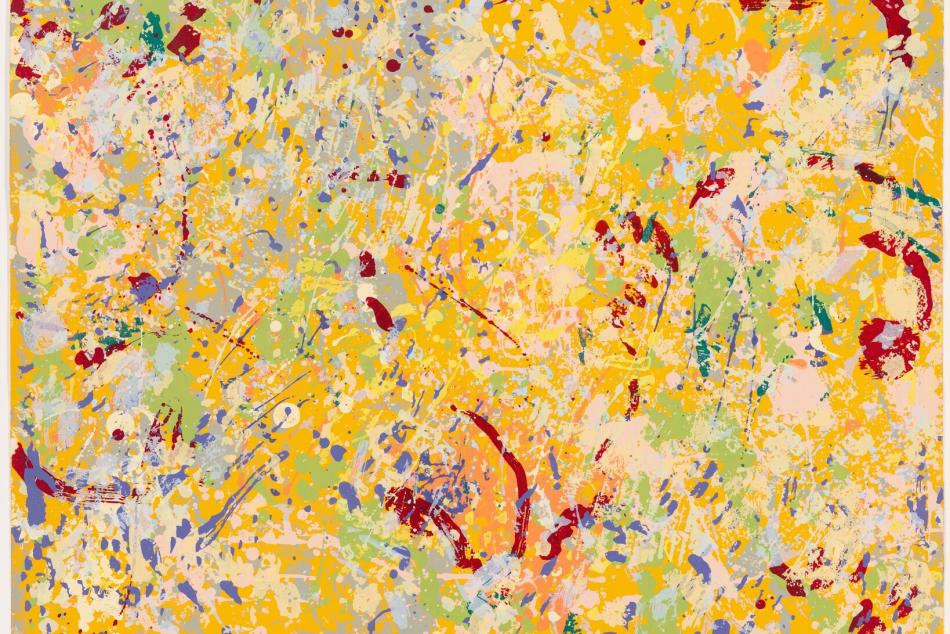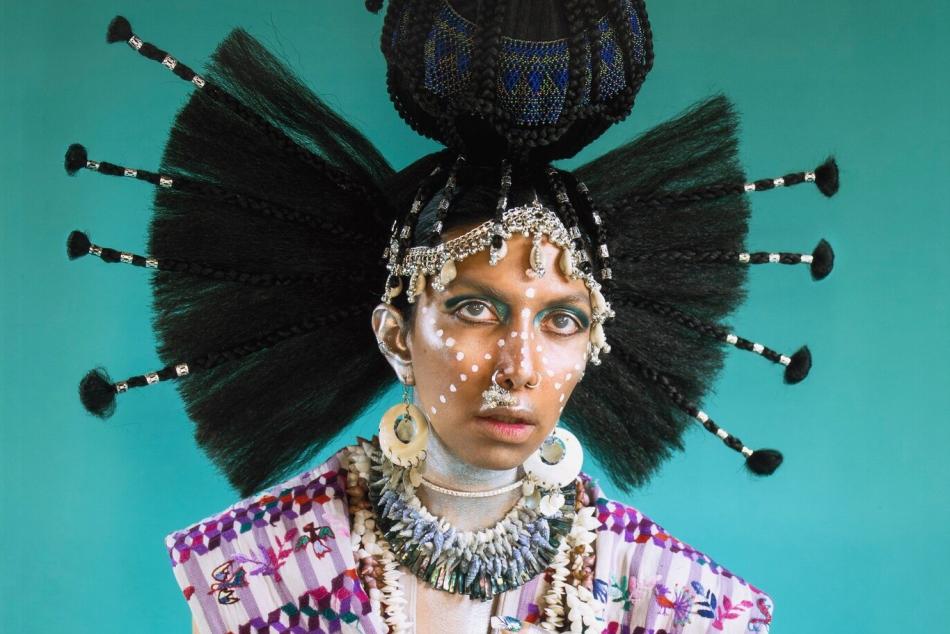10 Haitian Artists to Know

Dressed as a farmer, the patron spirit of agriculture prefers everything—from mice to candles—in threes. A far more menacing spirit waves a sword and a severed head, representing death. In a densely packed garden, Adam and Eve are surrounded by peacocks, spiders, and giraffes. In another tropical landscape, the Archangel Gabriel tells the Virgin Mary that she is pregnant with Jesus Christ. On his visit to a port city in 1901, a Haitian president enjoys a warm greeting. Wildcats engage in a fierce battle—likely a metaphor for political strife some 75 years later.
Haitian modern art is rich and complex. Artists depict stories from everyday life, political history, biblical tales, and symbolism from Vodou. (Haitian Vodou is a religion developed from the blending of multiple African tribal traditions among enslaved people in Haiti. Over time, its practitioners adapted some Roman Catholic traditions and created new ones specific to the Caribbean. Among the core practices of Vodou are healing, ancestral remembrance, and serving the spirits.)
And in the 20th century, leading Haitian painters gained international recognition. They influenced generations of African American artists, from Lois Mailou Jones to Betye Saar.
Learn about 10 of the country’s most significant modern and contemporary artists. You can see more of their works in our exhibition, Spirit & Strength: Modern Art from Haiti.

1. Rigaud Benoit
In Benoit’s Annunciation, the angel Gabriel and Virgin Mary have brown skin and curly black hair. The artist painted them as Haitians, and the lush tropical forest behind them suggests a Haitian landscape.
Born in the capital city of Port-au-Prince in 1911, Benoit kept Haiti at the center of his paintings—even biblical stories. In his lifetime, he became known internationally for precisely detailed scenes of daily life, Christianity, and Vodou.
Benoit was involved the Centre d’Art, a school and artistic center in Port-au-Prince. There, Haitian artists exchanged ideas with international artists and curators who were exploring the country’s art scene in the 1940s. Benoit was one of three artists tied to the Centre invited to paint altarpieces for the city’s Holy Trinity Cathedral. Most of that cathedral was destroyed in a 2010 earthquake. Today, we can only see photographs of Benoit’s painting, which depicted the birth of Jesus Christ.

Hector Hyppolite, 3 Marassa, 1947, oil on board, National Gallery of Art, Promised Gift of Beverly and John Fox Sullivan. Photo: Luke Christopher
2. Hector Hyppolite
Hyppolite’s 3 Marassa refers to the Vodou concept of marassa, a set of twins and the child born after them. Twins represent the transitional space between the living and the dead and are therefore considered very powerful.
Hyppolite gravitated toward such spiritual themes. In fact, he is said to be a third-generation houngan, or male Vodou priest. (This may, however, be a myth perpetuated by one of his fans—French surrealist painter André Breton.)
Regardless, Hyppolite’s fantastical scenes sometimes combined Christian and Vodou symbolism, often incorporating elements of nature. A friend of Benoit, Hyppolite was also involved in the Centre d’Art.

3. Myrlande Constant
Contemporary artist Myrlande Constant has described her textile work as “painting with beads.” In Guede Djable 2 Cornes, she depicts Guede, the black-colored spirit representing death. A live snake writhes around his neck as he brandishes a sword and a decapitated head.
Constant learned beading while working alongside her mother in a garment factory. She used it to pioneer a new style of drapo—ceremonial Vodou flags that feature symbols and mythical narratives. In addition to the traditional sequins, Constant’s drapo are densely beaded. This allows her to create intricately detailed and colorful compositions, sometimes at jaw-dropping scales.

4. Philomé Obin
Philomé Obin’s painting President Tiresias Sam Entering Cap-Haïtien shows a crowd applauding the Haitian president during his visit in 1901. Under Sam’s leadership, Haiti built railroads around the northern port city of Cap-Haïtien, providing new transportation pathways for both people and goods.
Obin was one of the founders of the Cap-Haïtien school, a painting style named for the city where it emerged. Like other artists of the school, Obin showed careful attention to street life and local architecture. The painter also contributed a fresco depicting Jesus Christ’s crucifixion to Port-au-Prince’s Holy Trinity Cathedral.

5. Louisiane Saint Fleurant
Mother with Children is typical of Saint Fleurant’s style: she was known for painting women and children in vibrant landscapes. Here, the mother’s head in profile hovers beside three children. They are set in an elaborate composition of many patterns in red, blue, yellow, and white. Tucked in the corners are birds and other creatures.
Saint Fleurant began painting in her late 40s after spending many years as a domestic worker. She became the oldest and only woman artist of the Saint Soleil movement, which formed in Soisson-la-Montagne (outside Port-au-Prince). The movement was characterized by abstracted figures and Vodou symbolism.

6. Castera Bazile
Bazile’s paintings showed scenes of daily life in both cities and rural communities. Cockfight depicts what was a popular pastime.
Bazile’s colorful portraits and scenes of daily life were shown in several exhibitions in Haiti, the United States, and Europe. By the time he died of tuberculosis at 43, he had become one of Haiti’s most successful artists. Like Obin and Benoit, Bazile was involved with the Centre d’Art and contributed a fresco to the Holy Trinity Cathedral.

7. Andre Pierre
Artist and houngan (male Vodou priest) Andre Pierre created intensely colored and lovingly detailed portraits of Vodou subjects. He depicted Mambo (a woman Vodou priest) as well as Baron Samedi, the chaotic ruler of the afterlife .
Pierre was regarded as the spiritual successor to Hector Hyppolite as the foremost painter of lwas (spirits). In fact, Pierre’s first paintings were made inside hollowed gourds used for ceremonial offerings to the lwas. It was in the 1950s that he began to paint on board and canvas. The artist wanted to show that Vodou is as respectable and important as other major world religions.

Jasmin Joseph, The Fight, 1975, oil on board, National Gallery of Art, Promised Gift of Beverly and John Fox Sullivan. Photo: Luke Christopher
8. Jasmin Joseph
In The Fight, Joseph painted wildcats leaping and attacking each other. This work may be related to Haiti’s political and economic upheaval of the mid-1970s to the early 1980s. At that time, the nation struggled with the corrupt regime of Jean-Claude “Baby Doc” Duvalier. Thousands of Haitians were tortured and killed and tens of thousands emigrated to the United States to escape.
Joseph was known for such striking paintings of animals, often engaged in human activities. Some of his works conveyed moral or religious themes. Others were satirical representations of public figures.

Wilson Bigaud, Adam and Eve, 1953, oil on board, National Gallery of Art, Promised Gift of Beverly and John Fox Sullivan. Photo: Luke Christopher
9. Wilson Bigaud
Adam and Eve shows a biblical scene chock-full of creatures. A boar wades in the water while a goat looks on from a riverbank. A peacock stands between Eve’s feet. The snake bursts out of a crack in the tree just above her outstretched hand. Notice the delicate spiderwebs spanning the tree branches and the spotted giraffes nearly camouflaged by the layers of details.
Wilson Bigaud was a student of Hector Hyppolite. He gained recognition at a young age for his skillful use of color, light, and shadow. His vivid paintings caught the eye of the US art world. The Museum of Modern Art in New York acquired his Murder in the Jungle shortly after the artist painted it at age 19.

Gérard Valcin, Papa Zaca, 1969, oil on masonite, National Gallery of Art, Promised Gift of Beverly and John Fox Sullivan
10. Gérard Valcin
Papa Zaca represents the patron lwa, or spirit, of agriculture in Vodou. He takes the guise of a farmer: barefoot, smoking a pipe, and dressed in blue denim and a straw hat. The tasseled bag to his right, a makout, is his best-known emblem. Papa Zaca likes the number three, so groups of three appear throughout the painting. Note the three mice, three drums, three candles, three cups, and so on.
Gérard Valcin, considered part of the second generation of modern Haitian artists, was known for his vibrant, playful paintings. Valcin painted Haitian Vodou ceremonies and beliefs in vivid detail.
You may also like

Article: 16 Black Artists to Know
Are you a fan of Glenn Ligon, Alma Thomas, or Gordon Parks? We’ve paired eight Black artists you might know with eight others to discover.

Article: 9 Latinx Artists You May Not Have Heard Of
Learn about the lives and works of artists of Latin American descent working in the United States from the 1930s to today.


